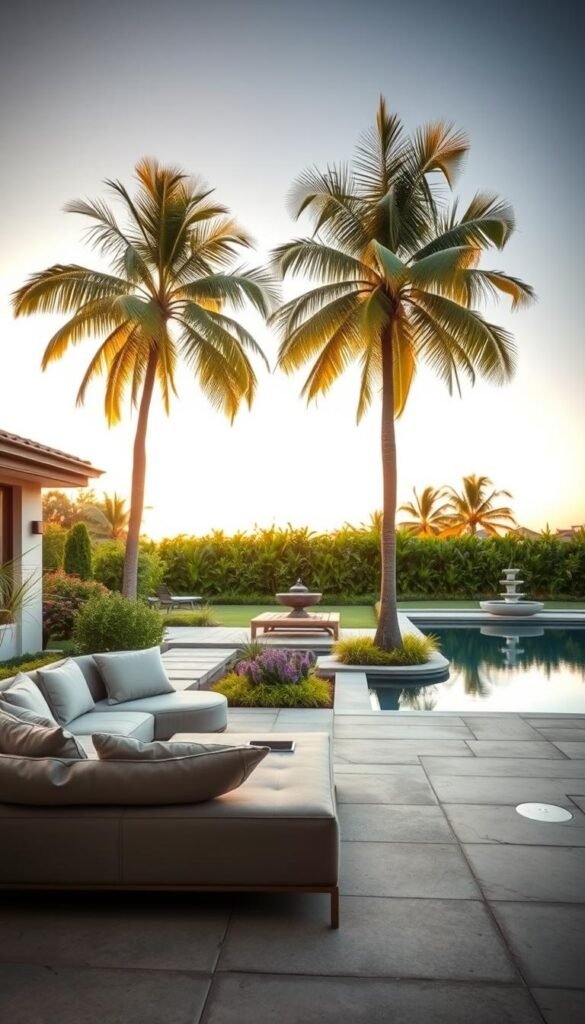Your outdoor area holds endless possibilities. With thoughtful planning, even modest plots can become inviting extensions of your home. Imagine a cozy corner for morning coffee or vibrant gathering spots for summer barbecues—all within steps of your door.
Great design isn’t about size but smart use of space. We’ll show you how to maximize every square foot, whether you’re working with a compact patio or open acreage. Discover how strategic plant choices and creative layouts can turn overlooked areas into functional zones that match your lifestyle.
This guide breaks down landscaping principles into easy steps. Learn to blend textures, colors, and materials for visual harmony. We’ll share budget-friendly ideas that deliver big impact, from DIY water features to multi-level planting beds.
Ready to craft an oasis that grows with your needs? Let’s explore solutions that balance practicality with personality, creating spaces where memories flourish season after season.
Understanding Your Outdoor Space Vision
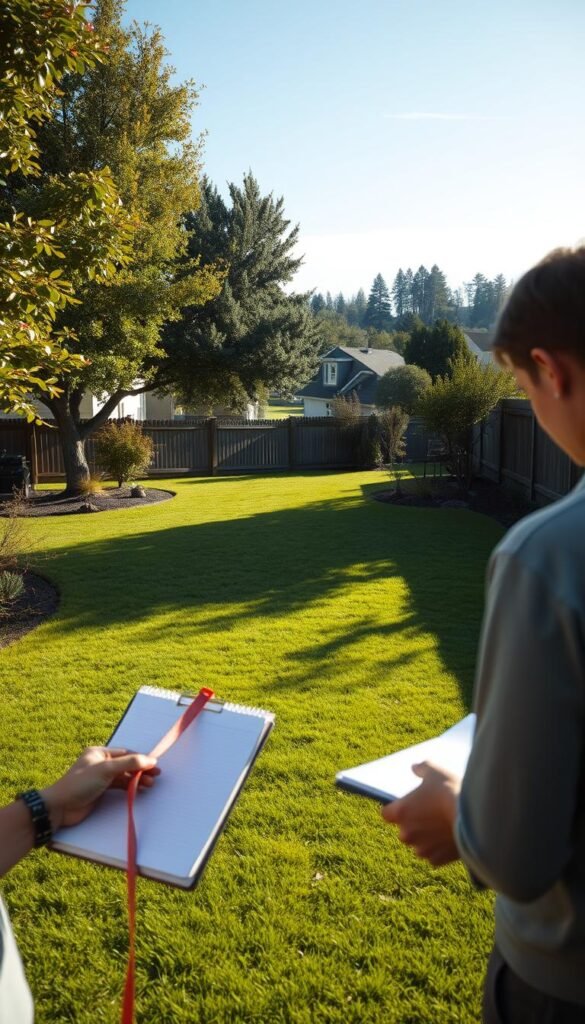
Unlocking your property’s hidden charm begins with clear vision. Start by observing how light dances across your space throughout the day. Morning sunbeams might highlight perfect breakfast nooks, while afternoon shade could reveal ideal spots for reading chairs.
Assessing Your Yard’s Potential
Grab a notebook and tour your area at different hours. Track where shadows fall and where water pools after rain. Notice existing features like mature trees or slopes that could shape your design. These elements aren’t obstacles—they’re free assets waiting to be used creatively.
| Focus Area | Morning | Afternoon | Evening |
|---|---|---|---|
| Sun Exposure | Full light | Partial shade | Low light |
| Activity Zones | Breakfast spot | Play area | Dining space |
| Natural Elements | Bird activity | Wind patterns | Firefly sightings |
Defining Your Outdoor Priorities
List your family’s must-haves versus nice-to-haves. A dining space for weekly barbecues might outrank that dream pizza oven if kids need room to play. Rank your top three goals—this hierarchy will guide every planting bed and patio stone placement.
Remember: Great designs grow from understanding what you truly need versus temporary wants. Your perfect layout balances daily joys with special occasion magic, all within your unique slice of nature.
Backyard Garden Inspiration: Transforming Simple Yards into Gorgeous Havens
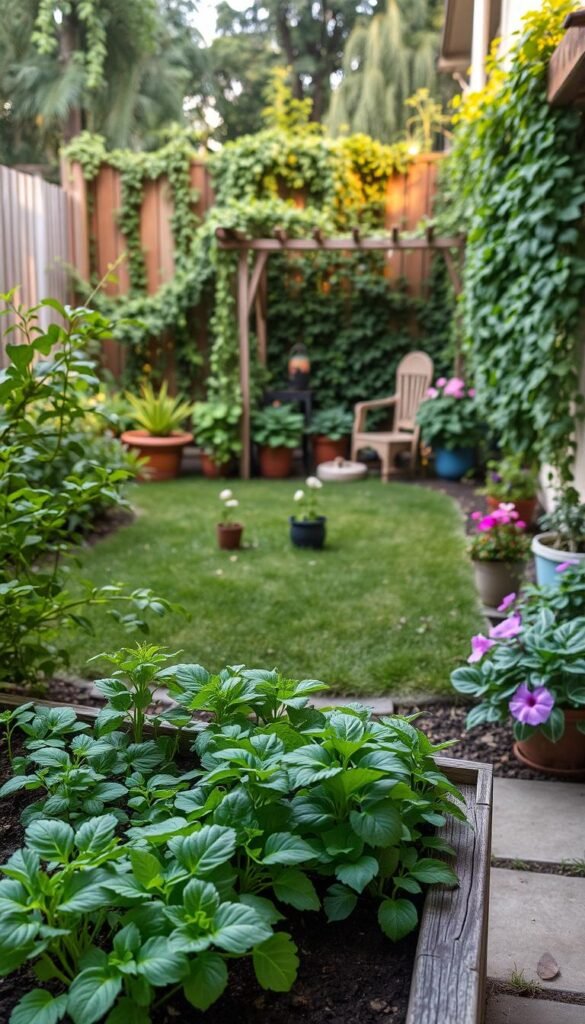
Space constraints spark creativity—a truth every designer knows. Many homeowners worry their compact outdoor areas lack potential, but pros see blank canvases brimming with possibilities. Small spaces force clever solutions that often outshine sprawling landscapes in charm and functionality.
Top designers approach tight quarters with a three-step mantra: elevate, layer, delight. Vertical planters turn walls into living art, while tiered seating creates conversation nooks. Mirrors strategically placed behind greenery can double the perceived depth of your area.
| Design Element | Small Space Solutions | Large Space Options |
|---|---|---|
| Vertical Gardening | Wall-mounted planters | Freestanding trellises |
| Multi-functional Furniture | Bench with storage | Separate seating/dining sets |
| Color Schemes | Monochromatic flow | Zoned color themes |
| Lighting | String lights + solar stakes | Pathway lamps + spotlights |
Your property’s existing features become design partners. A sloped section? Perfect for cascading herbs. Narrow side passage? Ideal for a succulent runway. Success lies in celebrating what you have, not mourning what’s missing.
Remember that iconic Kyoto temple garden measuring just 30 square meters? Its brilliance proves scale matters less than vision. Your cozy corner could become the neighborhood’s most memorable retreat with the right mix of imagination and practicality.
Planning Functional Layouts for Your Garden
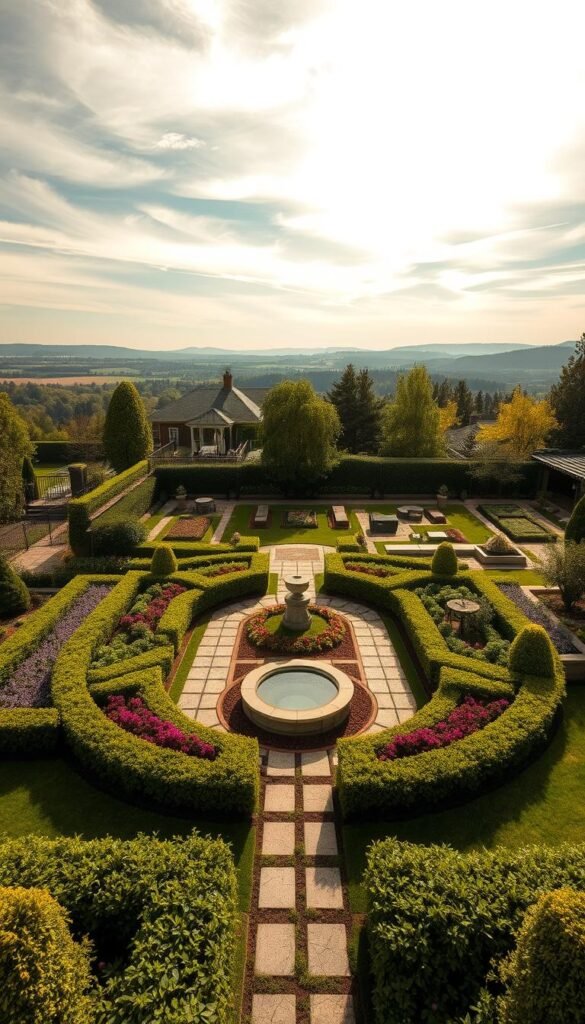
Effective outdoor designs transform foot traffic patterns into curated experiences. Professional planners often use a simple trick: they map movement routes before placing any furniture. This approach ensures your grill station won’t become a bottleneck during summer parties.
Creating Outdoor Rooms and Zones
Think of your property as a home’s natural floorplan. Dining areas work best near kitchen access, while reading nooks thrive in quiet corners. A well-planned landscape flows like your favorite rooms—connected but distinct.
| Zone Type | Defining Element | Space Needed |
|---|---|---|
| Dining | Weather-resistant rug | 8×10 ft minimum |
| Lounge | L-shaped seating | 10×12 ft ideal |
| Utility | Storage bench | 4×4 ft corner |
| Green | Vertical planter wall | Varies by plants |
Pathways deserve special attention—keep them at least 3 feet wide for comfortable strolls. “The magic of outdoor living lies in seamless transitions between functional spaces,” notes designer Mara Hoffman. For unique ways to decorate your outdoor, consider movable elements that adapt to different occasions.
Seasonal changes matter too. Position fire pits where winter winds won’t spoil the warmth. Summer dining spots might need afternoon shade. Your landscape should work as hard in December as it does in July.
Embracing Indoor-Outdoor Living
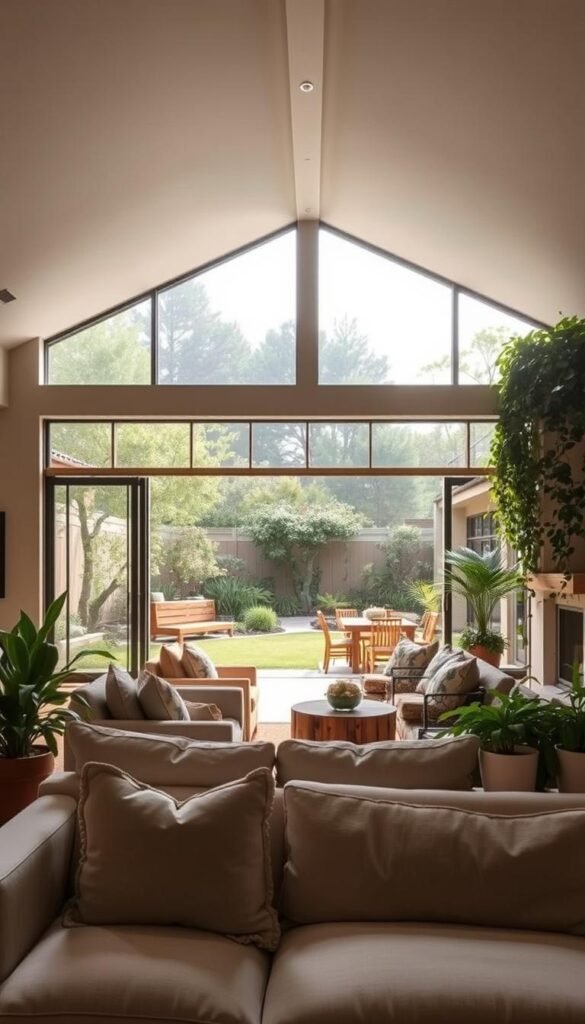
French doors do more than connect rooms—they weave stories between your home and the earth beyond. Modern design celebrates this connection, turning transitional spaces into heart-stealing features.
Bridging Comforts with Natural Beauty
Imagine stepping from your living room onto matching stone tiles that flow into the patio. This visual trick expands your perception of space. You might extend wood flooring outdoors or repeat cushion patterns from your sofa in weather-resistant fabrics.
| Design Element | Indoor Feature | Outdoor Adaptation |
|---|---|---|
| Flooring | Hardwood planks | Composite decking |
| Color Scheme | Neutral walls | Planter accents |
| Furniture | Sectional sofa | All-weather wicker |
| Lighting | Pendant lights | Lantern-style LEDs |
Large windows act as living paintings framing your nature-filled view. Container plants near entryways whisper “welcome” while mirroring indoor greenery. Outdoor rugs under dining sets create instant rooms under open skies.
The magic happens when boundaries dissolve. A firepit area with lounge chairs mirrors your den’s coziness. String lights above echo chandelier warmth. Your outdoor space becomes not just adjacent to your house, but part of its beating heart.
Maximizing Small Backyards with Smart Design
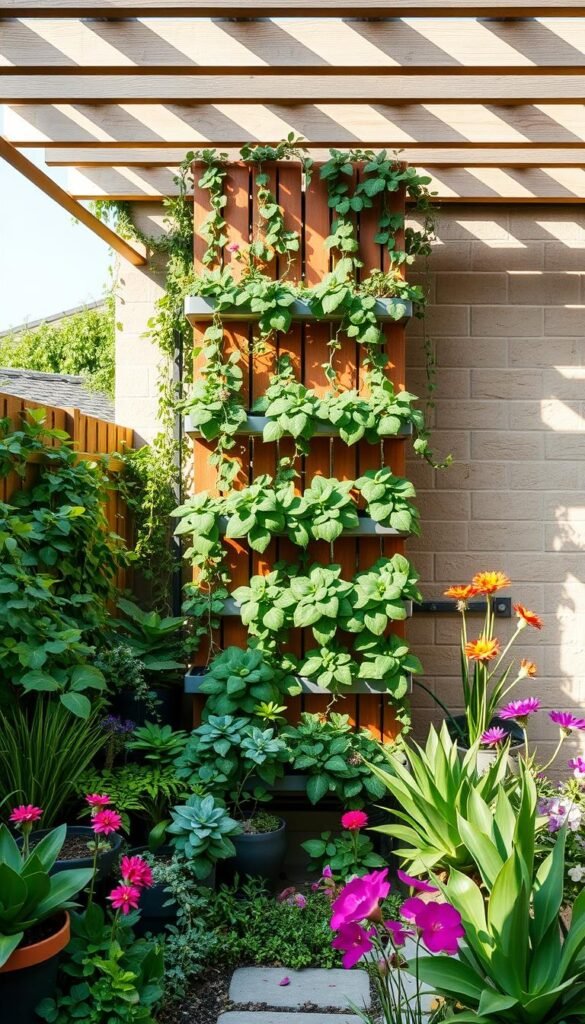
Why let ground boundaries limit your green dreams? Compact outdoor areas thrive when you shift perspective upward. Vertical surfaces become prime real estate for lush greenery that doubles as natural décor.
Reaching New Heights with Greenery
Wall-mounted planters transform blank fences into cascading herb displays. Trellises support climbing roses or edible vines—tomatoes and beans become living curtains. Even narrow side paths can host tiered stands bursting with succulents or flowers.
Smart design merges beauty with practicality. Built-in benches hide gardening tools underneath, while foldable tables create instant dining spots. Stackable containers let you rearrange plants like 3D puzzle pieces. These space-saving solutions prove small yards pack big potential.
- Repurpose old ladders as plant stands
- Hang window boxes under railings
- Use hanging baskets for strawberries
For urban dwellers, container setups offer a flexible way to grow fresh herbs. Wall pockets made from recycled materials add texture while saving floor space. Remember: Your vertical canvas creates depth, making tight areas feel expansive.
Light-colored walls reflect sunlight, helping plants thrive while brightening your backyard. Mix trailing ivy with upright rosemary for visual contrast. This layered approach turns limited square footage into an immersive retreat that feels larger than life.
Drawing Inspiration from Top Garden Designs
World-class gardens offer more than visual treats—they’re blueprints for your personal paradise. Designers at prestigious shows like Chelsea demonstrate how to marry artistry with practicality, creating spaces that spark joy through every season.
Lessons from Chelsea’s Masterpieces
Jo Thompson’s Glasshouse Garden dazzled with its clever use of recycled materials and layered textures. Tom Hoblyn’s Garden for Compassion proved serenity thrives in structured layouts, using water features and evergreen shrubs to create year-round interest. These design marvels show how strategic plant pairings elevate ordinary spaces into living art.
Tailoring Trends to Local Needs
North American landscaping priorities differ—our climate extremes demand resilient solutions. Many homeowners now choose native grasses and drought-tolerant perennials that withstand summer heat. “Successful schemes work with nature, not against it,” notes Denver designer Clara Bennett. This approach reduces upkeep while maintaining beauty through seasonal shifts.
Color strategies adapt too. Silver-leafed plants like lavender reflect sunlight in hot zones, while cold-resistant hellebores add winter color. Smart ideas borrowed from shows include:
- Grouping plants by water needs
- Using gravel paths as heat sinks
- Incorporating movable planters
By blending global inspiration with local wisdom, you create spaces that feel both timeless and uniquely yours. The best designs don’t copy—they adapt, ensuring your garden thrives in your specific slice of the world.
Selecting the Perfect Plants and Hardscape Materials
The final puzzle piece in crafting your outdoor retreat lies in thoughtful plant and material choices. Match greenery to your local climate—drought-tolerant lavender thrives in sunny spots, while coleus adds vibrant color to shaded corners. Consider maintenance levels: snake plants offer lush greenery with minimal care, perfect for busy households.
Hardscape materials set your space’s tone. Weather-resistant composite decking withstands seasonal changes, while terra cotta pots bring rustic charm to herb displays. For areas needing structure, stone pavers create clean lines that frame planting beds naturally.
Smart combinations elevate both beauty and function. Pair metal planters with trailing ivy for modern texture, or use wooden benches to soften sleek concrete surfaces. Patio container gardening solutions let you experiment with arrangements seasonally—swap spring pansies for fall mums without overhauling your layout.
Remember: Great designs balance living elements with built features. Let your plant picks reflect personal style while hardscapes provide lasting structure. This harmony creates spaces that feel both intentional and effortlessly inviting.

